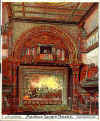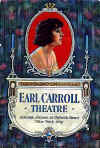Demolished Broadway Theatres - E to F
Compiled by John Kenrick
 This 1885 program cover
for the Madison Square Theatre shows a lavish Victorian interior. This
is where Gilbert and Sullivan's Pirates of Penzance premiered six
years before, when the space was called The Fifth Avenue Theatre (see
below).
This 1885 program cover
for the Madison Square Theatre shows a lavish Victorian interior. This
is where Gilbert and Sullivan's Pirates of Penzance premiered six
years before, when the space was called The Fifth Avenue Theatre (see
below).
(The images on this page are thumbnails – click on them to see larger versions.)
- Eagle
- Earl Carroll (1st)
- Earl Carroll (2nd)
- Edyth Totten
- Empire
- Fellows Opera House
- Fifth Avenue
- Fifth Avenue Opera House
- Follies Bergere
- Forty-Eighth Street
- Forty-Fourth Street
- Forty-Ninth Street
- Forty-Sixth Street
- Fourteenth Street
- Francaise
- Frazee
- Fulton
Eagle
Broadway at 33rd Street (Herald Square)
Later named: Standard Manhattan (1897-1909)
Built: 1884
Demolished: 1909
Seats: 1,100
Architects: J. B. McElfatrick & Sons
History: The first major theatre built on Herald Square, this
house was renamed the Standard in
1878, and the Manhattan
in 1897. It was demolished to make way for Gimbel's department store,
and the location is now a shopping mall.
Musicals: Robin Hood (1891)
 Earl Carroll (1st)
Earl Carroll (1st)
753 Seventh Avenue
Built: 1922
Demolished: 1930
Seats: 1,026
Architect: George Keister
Owner: Earl Carroll
History: Producer Earl Carroll
built this understated auditorium with money provided by Texas oil millionaire
Col. William R. Edrington. They decided to replace it with a larger house,
demolishing this building to make way for it.
Musicals: Earl Carroll Vanities (1923), Kid Boots
(1923), Earl Carroll's Sketchbook (1929)
Earl Carroll (2nd)
753 Seventh Avenue
Later name: Casino
Built: 1931
Demolished: 1990
Seats: 3,000
Architect: George Keister and Joseph Babolnay
Owner/Manager: Earl Carroll (1931-1932), Flo Ziegfeld (1932)
History: In an attempt to outshine the Ziegfeld Theatre, producer Earl
Carroll built this eye-popping art deco showplace with money provided by Texas
oil millionaire Col. William R. Edrington. Opening at the height of the
Great Depression, it drove Carroll and Edrington into crippling debt. A gleeful
Ziegfeld took over the house and renamed it the Casino
for a 1932 revival of Show Boat – but went bankrupt himself
months later. After a brief stint as a nightclub, the building
was converted to retail space in 1940. It was Whelan's Drugs Store,
which became a Woolworth's, and the public
gradually forgot that this structure had been a theatre. During
demolition in 1990, some of the colorful but long-hidden art deco
ornamentation was visible to bemused pedestrians.
Musicals: Earl Carroll Vanities (1931), Show Boat
(Revival - 1932)
Edyth Totten
247 West 48th Street
Later Named: President, Midget, Artef, American Show Shop,
Gilmore's, 48th Street, Erwin Piscator's Dramatic Workshop
Built: 1926
Demolished: 1988
Seats: 299
Architect: Paul C. Hunter
History: Originally named for the now-forgotten actress Edyth
Totten, this small theatre never had a
bona fide hit. Often renamed, it was frequently referred to as
the President because it stood across
the street from The President Hotel. The building became
part of Mamma Leone's Italian restaurant in 1955.
Empire
Same name also used by Eltinge
Theatre)
1430 Broadway near 40th Street
Built: 1893
Demolished: 1953
Seats: 1,099
Architects: J. B. McElfatrick & Sons; renovated by Carerre
& Hastings (1903)
Owner: Al Hayman
History: This intimate theatre was considered unattractive until the
interior was redecorated in 1903. The Empire then
became one of the most beloved Broadway theatres of its era, housing such
non-musical hits as Life With Father (1939) and Member of the
Wedding (1950).
Fellow's Opera House
444 Broadway
Opened: 1850
Demolished: 1866
History: Located in the City Assembly Rooms building, this space was
briefly the home of Christy's Minstrels.
Fifth Avenue
27 West 28th Street (NW Corner)
Also named: Gilsey's Apollo Hall, St. James (1870), New Fifth
Avenue, Madison Square (1891), H.C. Miner's 5th Avenue Theatre
Built: 1860s, Rebuilt after fire in 1891
Demolished: 1939?
Seats: 1,529
Note: Although not on Fifth Avenue, this theatre took its
most lasting name from an opera house that burned down in
1873 – see below for details. An 1877 renovation included an
innovative ventilation
system that blew air over blocks of ice, making this the world's first
air conditioned theatre. In the 1880s, it was one of the most popular
venues for operetta. Destroyed by fire in 1891, it was rebuilt at
the same location and renamed the Madison
Square. It became a vaudeville house in 1900
and hosted burlesque as of 1929. It was a movie house
when it shut down in the late 1930s.
Musicals: The Pirates of Penzance (1879 - US Premiere)
Fifth Avenue Opera House
Fifth Avenue at 24th Street
Later named: Fifth Avenue Theatre, Broughman's
Built: 1865
Demolished: 1873 (fire)
Note: From 1869 on, this house was managed by Augustin Daly. When
the theatre burned down, hard times delayed rebuilding. A new theatre was built on 28th
Street (see above).
Musicals: The Christy Minstrels performed here, followed by
comedies and major burlesque troupes.
Follies Bergere
206 West 46th Street
Later names: Fulton, Helen Hayes
Built: 1911
Demolished: 1982
Seats: 895
Architects: Herts & Tallant
Owners: Henry B. Harris and Jesse Lasky (1911-1921), A.L. Erlanger
(1921-??)
History: Originally a Parisian-style nightclub, this elegant auditorium
was soon converted to legitimate theatrical use and renamed the Fulton.
It was named for actress Helen Hayes in 1955, and housed many important
plays. It was one of five theatres demolished to make way for the Marriott Marquis Hotel.
Musicals: New Faces of 1934, The Me Nobody Knows
(1970)
Forty Eighth Street
(Same name used briefly by Edyth Totten)
157 West 48th Street
Later Named: Windsor
Built: 1912
Demolished: 1966
Seats: Unverified - under 1,000
Architect: William A. Swasey
History: This intimate house was named the
Windsor from 1937 to 1943, then returned to its original
name. Its longest running tenant was the comedy Harvey (1944).
Musicals: Hayride (1954)
Forty Fourth Street
- see Weber and Fields' Music Hall
Forty Ninth Street
235 West 49th Street
Later Name: Cinema 49
Built: 1921
Demolished: 1940
Owners/Managers: The Shuberts (1921-1933)
Architect: Herbert J. Krapp
History: Built by the Shubert Brothers, who sold it during the Great
Depression. This was a movie theatre from 1938 until its demolition two years
later.
Musicals: Chauve-Souris (1922)
Forty Sixth Street
- see Richard Rodgers Theatre
Fourteenth Street
14th Street between 6th and 7th Avenues
Also named: Theatre Francaise (1866), Fourteenth Street (1870), Lyceum (1872), Haverly's
14th Street (1879), Fourteenth Street (1885)
Built:1866
Demolished: 1936
History: This house was built by producers M. Guignet & C. Drivet to hold
French plays and comic operas. After four years, new owners renamed it
and switched to a less restricted booking policy. This handsome house became home to J.H. Haverly's minstrel troupe. It
had a final blaze of glory as home to Eve Le Gallienne's Civic Repertory
company 1926-1932.
Francaise
14th Street between 6th and 7th Avenues
- see 14th Street
Note: The name
"Theatre Francaise" was also used briefly by the
Astor Place Opera House
(1851-53) and Koster & Bial's
(1877-78).
Frazee
- see Lew Fields
Fulton
- see Follies Bergere
